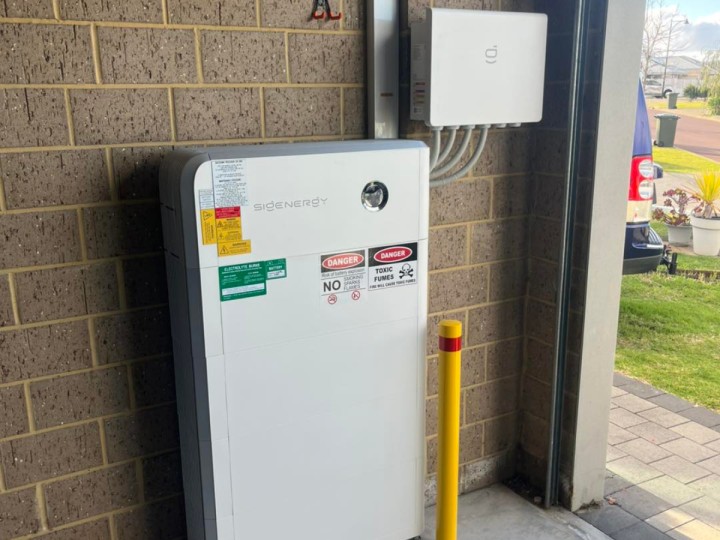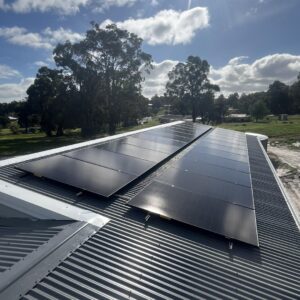Introduction
The move towards renewable energy is not just an environmental choice; it’s increasingly a financial one. Across Western Australia, households are cutting power bills and reducing grid reliance by pairing rooftop solar with battery storage. With the support of government rebates and loan schemes, storage has become more accessible than ever, unlocking long‑term benefits for families in the South West.
This guide explores how rebates can reduce upfront costs, the financial and environmental advantages of batteries, and practical steps for households ready to make the switch. Whether you’re new to solar or looking to expand your system, understanding your options will help you maximise returns.
Why Combine Solar Panels with Batteries?
Solar panels generate electricity during the day, often producing more than a household consumes. Without storage, this excess energy flows back into the grid at a low buyback rate under WA’s Distributed Energy Buyback Scheme (DEBS). Batteries change the equation by storing this energy for later use, particularly in the evening when demand (and costs) rise.
By adding a battery, households can:
1. Reduce dependence on the grid
2. Offset peak electricity prices
3. Improve energy independence
4. Support resilience during blackouts (with the right setup
5. For many families, the motivator is savings.
Stored solar power used in the evening replaces expensive grid electricity, and with rebates and loans available, the payback period improves further.
Understanding Solar Battery Rebates in Western Australia
WA’s Residential Battery Scheme makes battery storage more affordable for eligible households. The program provides a rebate and, for some, access to interest‑free loans, helping reduce upfront costs and make storage more achievable.
Key points include:
1. Eligibility – Households must be Synergy or Horizon Power customers, with criteria around products and participation.
2. Virtual Power Plant (VPP) – Joining a VPP is a requirement. This lets batteries work together as part of a wider network, benefiting both households and the community.
3. Approved Suppliers and Products – Systems must be installed by accredited vendors with approved batteries and inverters.
4. Application Process – Your installer (such as MaxSolar) manages the application on your behalf after system design and quoting.
5. No Retrospective Rebates – Rebates only apply to approved, new installations.
Combined with the Federal Government’s Cheaper Home Batteries Program, the WA scheme offers homes in the South West practical support to invest in storage.
Financial Benefits of Adding Battery Storage
Beyond rebates, batteries deliver strong financial benefits over their lifetime. The primary gain is increased self‑consumption of solar energy. By using more of what you produce, you reduce imports from the grid, which are typically at higher tariff rates.
Some financial advantages include:
1. Bill Reduction – Lower annual spend on electricity by storing solar power for evening use.
2. Peak Avoidance – Offset usage when tariffs are highest.
3. Improved ROI – Rebates and financing shorten payback periods, improving affordability.
4. Grid Credits via VPPs – By joining a Virtual Power Plant, households can earn credits when their battery supplies energy back to the grid at times of high demand.
While savings vary between households, the combination of rising electricity prices and government support makes batteries increasingly compelling.
Environmental and Community Advantages
Batteries aren’t just about bills. They also contribute to larger environmental and community goals:
1. Lower emissions – Less reliance on fossil‑fuel‑powered electricity.
2. Grid stability – VPP‑connected batteries enhance grid resilience by acting as distributed storage hubs.
3. Energy independence – Stronger community resilience, particularly beneficial in regional areas.
These benefits underline why governments incentivise storage: it helps Australia transition to cleaner, more dependable energy.
Practical Considerations Before Installing a Battery
Batteries are a long‑term investment, so households should weigh several factors before deciding.
1. System Sizing – Choose a battery size that suits your usage and solar generation.
2. Battery Chemistry – Lithium‑ion remains the most common, but newer technologies are emerging.
3. Backup Capability – Not all batteries automatically provide backup during outages — MaxSolar can design systems with Tesla or SENEC batteries to include this feature if required.
4. Warranty & Lifespan – Look for strong warranties (often ten years).
5. Scalability – Consider flexible systems if you expect your energy needs to grow.
Consulting with a trusted local installer ensures your setup is cost‑effective, reliable and designed for your property’s needs.
How to Maximise the Value of Your Solar Battery
Installing a battery is just the beginning. How you use it affects results.
1. Optimise settings – Tailor discharge and charging schedules to match tariffs.
2. Monitor performance – Ensure the system is operating efficiently.
3. Use smart appliances – Shift usage to align with solar and storage availability.
4. Stay tariff‑aware – Choose electricity plans that complement your system.
The Future of Solar Storage in WA and Australia
Australia leads the world in rooftop solar, and battery uptake is quickly gaining pace. In WA, rebates and VPP participation are accelerating adoption. Key trends include:
1. Expanded VPPs – Households earn credits while supporting grid reliability.
2. Second‑life batteries – Re‑used EV batteries entering the home market.
3. Smarter management systems – AI tools that optimise usage patterns.
The combination of falling battery prices, rising electricity rates and government incentives points toward a future where storage becomes standard.
Conclusion
For households in the South West of WA, the pairing of solar panels with batteries represents a smart way to cut power costs, increase energy independence, and contribute to a cleaner future. WA’s Residential Battery Scheme makes the investment more affordable and accessible, while programs like VPPs create additional value.
With tailored installation and support, MaxSolar helps households design the right solution. Whether your goal is lower bills, blackout resilience, or sustainable living, the time to explore solar storage is now.
Frequently Asked Questions
1. Are solar battery rebates still available in WA?
Yes. The WA Residential Battery Scheme provides rebates and optional no‑interest loans for approved systems, with participation in a Virtual Power Plant required. Federal incentives may also apply.
2. How much money can I save with a battery system?
Savings depend on your household’s energy use, tariffs, and battery size. While results vary, most homes benefit from higher self‑consumption and lower grid imports.
3. What size battery do I need for my home?
It depends on your energy consumption and solar generation. MaxSolar can recommend the right size based on your needs.
4. Do batteries work during blackouts?
Not all batteries provide backup by default. MaxSolar installs Tesla and SENEC systems that can include blackout protection if required.
5. Who applies for the WA Battery Rebate?
Applications are handled by accredited installers like MaxSolar after quoting and approval. Rebates cannot be applied retrospectively.
References:
1. WA Residential Battery Scheme (rebates + VPP details): Energy Policy WA
2. Federal Small‑scale Renewable Energy Scheme (solar incentives): Clean Energy Regulator
3. Synergy Distributed Energy Buyback Scheme (DEBS): Synergy WA
Internal Links:
1. Battery Storage Services: MaxSolar Battery Storage
2. Solar Panel Systems: MaxSolar Solar Panels
3. Off‑Grid Solutions: MaxSolar Off‑Grid Solutions
4. Rebate Information: MaxSolar Rebates
5. Blog – Best Solar Battery in Australia: What Is the Best Solar Battery in Australia?








